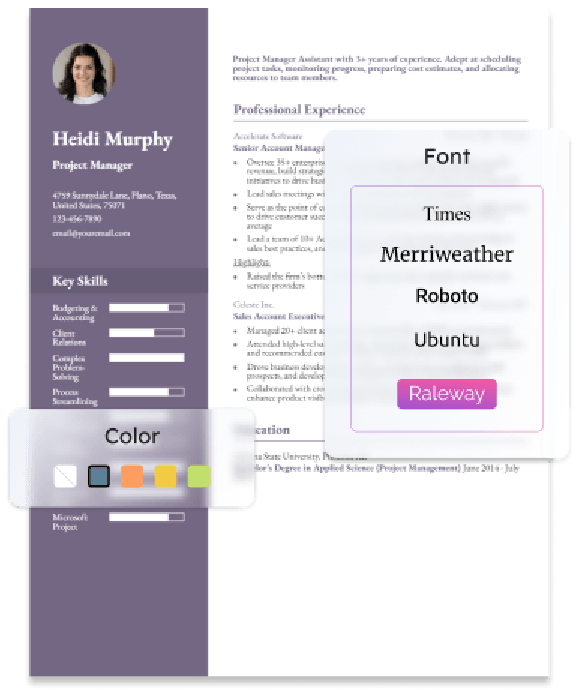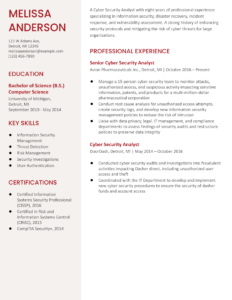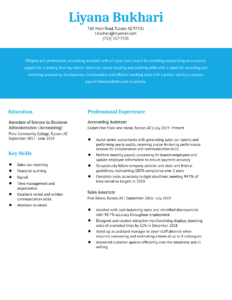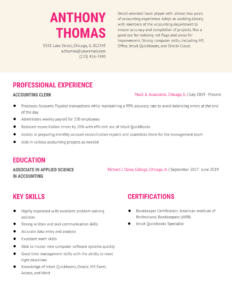How To Write an Emergency Medical Technician Resume
A strong emergency medical technician (EMT) resume that highlights your skills in trauma care, crisis management and patient stabilization can help you stand out in a competitive job market. Learn expert tips and advice on how to write an engaging resume. We’ll guide you through each section, highlighting best practices and providing EMT resume examples to help you create an impactful resume that showcases your medical and emergency qualifications and sets you apart from other candidates.
- Entry-Level
- Mid-Career
- Senior-Level
1. Craft an outstanding profile summarizing your emergency medical technician qualifications
Grab the attention of hiring managers immediately by presenting your most relevant EMT experience and top qualifications. Keep your profile concise, summarizing your professional background and ability in two to three sentences. Mention your years of experience, skills, and specializations that would make you the perfect fit for the job. Explain you deliver exceptional medical care and patient support in high-pressure emergencies or emphasize your effective communication skills and ability to collaborate with other health care professionals.
Senior-Level Profile Example
An EMT with over 10 years of experience specializing in pre-hospital care, patient management, emergency medical services (EMS), and pharmaceutical interventions. A strong history of managing crisis situations and providing empathetic care to patients during medical emergencies. Adept at collaborating with medical teams and public agencies to achieve positive patient outcomes.
Entry-Level Profile Example
A certified EMT with entry-level experience specializing in patient transport, pre-hospital care, communication, and ambulance operations. Adept at coordinating with medical teams to deliver emergency treatment to patients in crisis situations.
2. Create a powerful list of your emergency medical technician experiences
When writing about your professional experience, focus on the outcomes of your work rather than just the tasks you performed. Give specific examples of how you contributed to the success of a particular situation or case, such as reducing response times, providing life-saving interventions, or successfully transporting critically ill patients. Tailor each point to the specific job you’re applying for, highlighting experiences most relevant to that position. Use numbers and specific metrics when possible to quantify the impact you’ve had in your work.
Senior-Level Professional Experience Example
Emergency Medical Technician (EMT), LA Medical Center, Los Angeles, CA
May 2016 – present
- Deliver emergency medical services to over 75 patients per week during COVID-19, evaluate vital signs, blood pressure, and oxygen levels, administer nebulizer therapy and oxygen, and ensure compliance with COVID-19 safety protocols during patient transport
- Administer pre-hospital care to patients suffering from strokes, neurological emergencies, and immunological emergencies and communicate with families and patients to gather medical history and deliver appropriate treatment
- Provide training to more than 15 EMTs on EMS procedures, hospital policies, patient triage, and safety regulations
Entry-Level Professional Experience Example
Emergency Medical Technician (EMT), Southwest Medical, Nashville, TN
June 2021 – present
- Deliver first aid, basic life support, and emergency medical treatment to more than 50 patients per week in a wide range of emergency medical situations
- Ensure the safe transport of patients and administer appropriate medical treatment on-scene and en route to hospitals, including CPR and pharmaceutical interventions
- Conduct preventative maintenance on ambulatory vehicles and perform equipment inspections to identify potential defects
- Communicate with patients and families on-site to obtain medical histories and determine appropriate treatments based on symptoms
3. Include emergency medical technician-related education and certifications
Make sure your education and certification sections are clear and concise, emphasizing the specific qualifications that make you a strong applicant. Start by listing your highest level of education. Give the name of the degree and institution, where you attended, and your enrollment dates. Include any other relevant coursework or degrees.
As an EMT, you’ll also include a certification section on your resume. Similarly, you’ll provide the name and location of the certification and the date you received it. You can also include extra EMT-specific certificates that may not be required for the job but show your extensive qualifications.
Education
Template
- [Degree Name]
- [School Name], [City, State Abbreviation] [Dates Enrolled]
Example
- Bachelor of Science (B.S.) Emergency Medical Services (EMS)
- University of Pennsylvania, Philadelphia, PA September 2012 – May 2016
Certifications
Template
- [Certification Name], [Awarding Organization], [Completion Year]
Example
- EMT-Advanced Certification from the National Registry of Emergency Medical Technicians (Active), June 2018
- EMT-Basic Certification from the National Registry of Emergency Medical Technicians (Active), June 2016
4. List your emergency medical technician-related skills and proficiencies
Hiring managers look for specific skills when reviewing resumes, so feature those mentioned in the job description or essential to the role. These should include technical skills (e.g., knowledge of medical equipment and procedures) and soft skills (e.g., communication and problem-solving). By creating a robust key skills section, you can quickly capture readers’ attention and demonstrate you have the exact qualifications they seek in an EMT. Consider incorporating skills into your EMT resume like the ones we’ve listed below:
| Key Skills and Proficiencies | |
|---|---|
| Advanced Cardiovascular Life Support (ACLS) | Ambulance operation |
| CPR | Crisis management |
| Empathetic care | Endocrine emergencies |
| HIPAA compliance | Medication administration |
| Patient stabilization | Pediatric advanced life support (PALS) |
| Pharmaceutical intervention | Post-resuscitation care |
| Toxicological emergencies | Trauma care |
How To Pick the Best Emergency Medical Technician Resume Template
The best resume template for an EMT is clean, professional, and easy to read. Your resume must stand out for all the right reasons by highlighting your most relevant professional accomplishments and key skills. So, avoid cluttered and overly decorative templates that can have the opposite effect of what you’re hoping for. Make it easy for recruiters and hiring managers to see why you’re the best person for the job. Choosing the right template is the best place to start.
Emergency Medical Technician Text-Only Resume Templates and Examples
- Entry-Level
- Mid-Career
- Senior-Level
Jennifer Taylor
(123) 456-7890
[email protected]
123 Your Street, Philadelphia, PA 12345
Profile
An EMT with five years of experience specializing in patient care, EMS, and crisis management. A proven track record of administering CPR and emergency treatment to patients in toxicological and immunological crisis situations. Adept at interfacing with diverse teams and patient populations.
Professional Experience
Emergency Medical Technician (EMT), Penn Hospital, Philadelphia, PA
May 2018 – present
- Administer emergency treatment to patients in life-threatening medical situations, conduct on-scene patient assessments to evaluate injuries and vital signs, and communicate with families and patients to identify treatments based on medical history
- Provide EMS to diverse patient populations and communicate with empathy and compassion to calm patients during medical emergencies
- Deliver pre-hospital care and perform pharmaceutical interventions for toxicological emergencies, including opioid overdose, poisoning, and allergic reactions
Emergency Medical Technician (EMT), Temple Hospital, Philadelphia, PA
May 2016 – May 2018
- Coordinated with EMS teams, law enforcement, and firefighters to respond to 911 calls and crisis situations, including car accidents, fires, and at-home medical emergencies
- Performed on-site patient assessments, administered CPR and post-resuscitation care, conducted trauma triage and hemorrhage control
- Ensured compliance with EMS culture of safety and conducted inspections of ambulances and medical equipment to maintain safe and sterile environments during transport
Education
Bachelor of Science (B.S.) Emergency Medical Services (EMS)
University of Pennsylvania, Philadelphia, PA September 2012 – May 2016
Key Skills
- Crisis management
- EMS
- Pharmaceutical interventions
- Pre-hospital care
- Toxicological emergencies
Certifications
- EMT-Advanced Certification from the National Registry of Emergency Medical Technicians (Active), June 2018
- EMT-Basic Certification from the National Registry of Emergency Medical Technicians (Active), June 2016
- Advanced Life Support (ALS), American Heart Association, June 2016
Frequently Asked Questions: Emergency Medical Technician Resume Examples and Advice
What are common action verbs for emergency medical technician resumes?-
Crafting a powerful professional experience section can be challenging, especially when you run out of action verbs to describe your work as an EMT. We've compiled a list of common verbs to showcase your accomplishments and experience more dynamically.
| Action Verbs | |
|---|---|
| Administered | Assessed |
| Collaborated | Communicated |
| Documented | Educated |
| Evaluated | Immobilized |
| Maintained | Monitored |
| Prioritized | Reassured |
| Responded | Resuscitated |
| Stabilized | Transported |
| Treated | Updated |
How do you align your resume with a job description?-
Employment of EMTs and paramedics is expected to increase by 7% over the next 10 years, creating over 17,000 new jobs. As new applicants continue to flood the market and attempt to meet this demand, you’ll need to be strategic about crafting your resume. Tailoring your resume to match a position is the best approach to take. Become the answer to their needs by aligning your EMT resume with the job description, increasing your chances of standing out and securing an interview.
What is the best emergency medical technician resume format?-
When selecting a resume format, it’s essential to consider the employer's preferences and the specific job posting. A chronological resume format (as seen in our examples above) is typically the most effective for EMTs, as it first displays your career progression and shows your most recent experience. Emphasizing your latest work is particularly important in the health care industry, where skills and technologies constantly evolve. This resume format demonstrates your commitment to the field and willingness to learn and grow professionally.
Craft your perfect resume in minutes
Get 2x more interviews with Resume Builder. Access Pro Plan features for a limited time!

Creating a well-written cover letter to accompany your resume will help your chances of getting an interview. The best way to write a compelling cover letter is to tailor your document for the health care institution you’re applying to. Read our guide on how to write a cover letter for some great advice, and check out our health and wellness cover letter guides to see examples for other medical positions.







